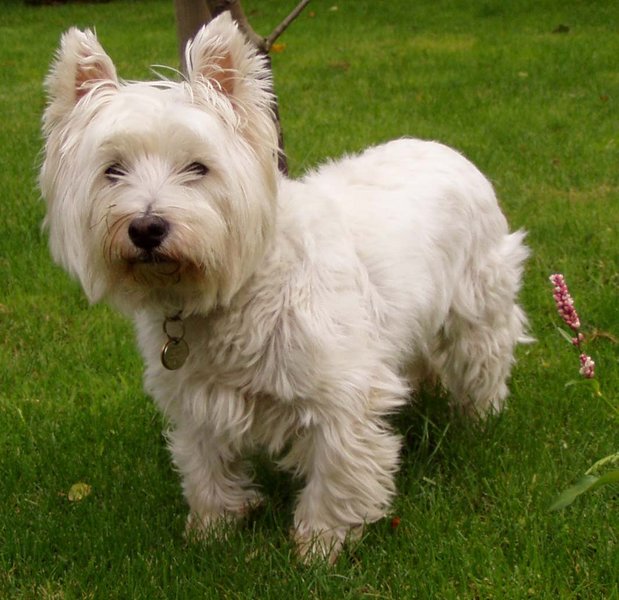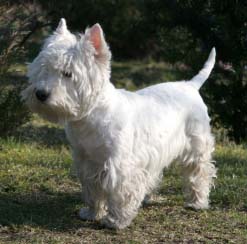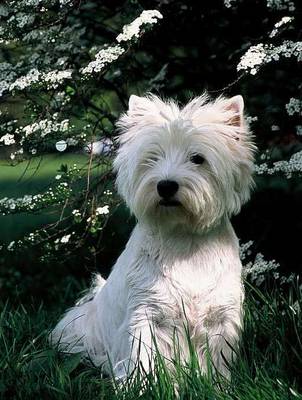Other: Other Related Research
West Highland White Terriers
By Michael Walter Lambert (05/09/09 18:22:07)
Related animal: Dog
My project is on the dog. More specifically the breed West Highland White Terrier. More commonly known just as the "Westie."
History: Dogs descended from the wolf. The first domestication of the wolf was about 12,000 years ago. Humans discovered the wolf as a great asset as a pet who could hunt along side us and guard us while we slept. Dogs learned to cooperate with humans through thousands of years of evolution and adaption in human society. As years went by the wolf began to mutate into different breeds, through natural mutation, different climates, and environments. Different dogs were able to be grouped as hunters, herders, guard watchers, and companion and lap dogs. Westies are mainly companions but can be used as guard dogs despite their small size.
West Highland White Terrier (facts and descriptions): Originally from Scotland the Westie could be described as robust, friendly, cocky, and spunky. Friendly even to strangers and get along well with children. They are self assured towards other dogs but will not pick fights with other dogs. Westies love companionship. Westies are small about a foot tall and weigh about 22 lbs. Known for their distinctive white coat, a two inch white coat uncurled with a soft dense undercoat that should be groomed regularly. They have dark deepset eyes with a penetrating gaze. Described as sturdy, hardy, and compact. Their ears are small, pointed, and erect. Their tail is roughly six inches long and they have muscular limbs. They have a short close fitted jaw, a convex jaw, and. thickly padded paws. Westies are easy to train and like to bark and dig. Originally bred for controlling populations of rats, foxes, and other vermin. The breed gained its distinctive coat after Colonel Edward Malcolm' s red terrier was mistaken for a fox and shot. Malcolm only bred white westies to distinguish it from game.
Dog senses (although vary): A dogs sense of smell is by far their most acute. Some say it is immeasurably better than that of humans but others measure it at about 100,000 times that of a human. This helps with tasks such as finding missing persons, digging underground, and tracing toxic substances. Dogs can detect drugs, explosives, and the scent of their masters. Dogs have a generally poor or weak sense of taste, and will eat almost anything. The dogs next greatest sense is that of hearing, also much greater than a humans ability, with the ability to filter out distracting noises. Dogs can identify prey, predators, as well as their origin based on sound. Dogs have relatively poor eyesight and are technically color blind although they can discern different colors by their shade of grey. Sight is practical for dogs. They can detect movement from a far. Also dogs can see better in poor light than humans and have a better visual range roughly 180 degrees. Dogs can't always identify what they see so they must rely on their other senses. Dogs are sensitive to touch, their bodies are covered with sensitive nerve endings.
Play Behavior: Play behavior was the subject of my art project with my dog the westie Mac! Mac and I painted a picture out of mud with our extremities, played life guard and soccer. As we know dogs love to play, they play ball and chase wheels. Forms of play for dogs are to lick, bark, nip, chew, dig, rough house, and fetch. Other interesting facts, dogs are known to be telepathic and help as healers for the sick (dogs help patients through periods of illness).
[Write Comment]
By Michael Walter Lambert (05/09/09 18:22:07)
Related animal: Dog
My project is on the dog. More specifically the breed West Highland White Terrier. More commonly known just as the "Westie."
History: Dogs descended from the wolf. The first domestication of the wolf was about 12,000 years ago. Humans discovered the wolf as a great asset as a pet who could hunt along side us and guard us while we slept. Dogs learned to cooperate with humans through thousands of years of evolution and adaption in human society. As years went by the wolf began to mutate into different breeds, through natural mutation, different climates, and environments. Different dogs were able to be grouped as hunters, herders, guard watchers, and companion and lap dogs. Westies are mainly companions but can be used as guard dogs despite their small size.
West Highland White Terrier (facts and descriptions): Originally from Scotland the Westie could be described as robust, friendly, cocky, and spunky. Friendly even to strangers and get along well with children. They are self assured towards other dogs but will not pick fights with other dogs. Westies love companionship. Westies are small about a foot tall and weigh about 22 lbs. Known for their distinctive white coat, a two inch white coat uncurled with a soft dense undercoat that should be groomed regularly. They have dark deepset eyes with a penetrating gaze. Described as sturdy, hardy, and compact. Their ears are small, pointed, and erect. Their tail is roughly six inches long and they have muscular limbs. They have a short close fitted jaw, a convex jaw, and. thickly padded paws. Westies are easy to train and like to bark and dig. Originally bred for controlling populations of rats, foxes, and other vermin. The breed gained its distinctive coat after Colonel Edward Malcolm' s red terrier was mistaken for a fox and shot. Malcolm only bred white westies to distinguish it from game.
Dog senses (although vary): A dogs sense of smell is by far their most acute. Some say it is immeasurably better than that of humans but others measure it at about 100,000 times that of a human. This helps with tasks such as finding missing persons, digging underground, and tracing toxic substances. Dogs can detect drugs, explosives, and the scent of their masters. Dogs have a generally poor or weak sense of taste, and will eat almost anything. The dogs next greatest sense is that of hearing, also much greater than a humans ability, with the ability to filter out distracting noises. Dogs can identify prey, predators, as well as their origin based on sound. Dogs have relatively poor eyesight and are technically color blind although they can discern different colors by their shade of grey. Sight is practical for dogs. They can detect movement from a far. Also dogs can see better in poor light than humans and have a better visual range roughly 180 degrees. Dogs can't always identify what they see so they must rely on their other senses. Dogs are sensitive to touch, their bodies are covered with sensitive nerve endings.
Play Behavior: Play behavior was the subject of my art project with my dog the westie Mac! Mac and I painted a picture out of mud with our extremities, played life guard and soccer. As we know dogs love to play, they play ball and chase wheels. Forms of play for dogs are to lick, bark, nip, chew, dig, rough house, and fetch. Other interesting facts, dogs are known to be telepathic and help as healers for the sick (dogs help patients through periods of illness).

| 
|

|